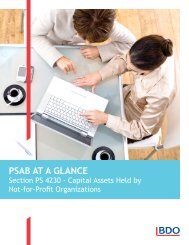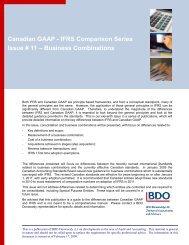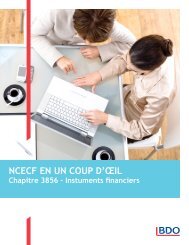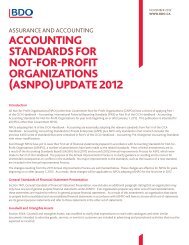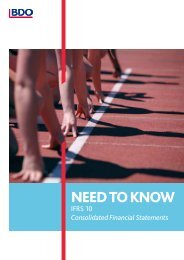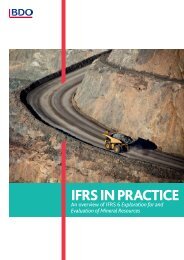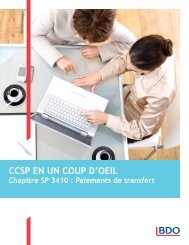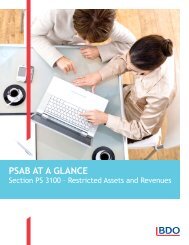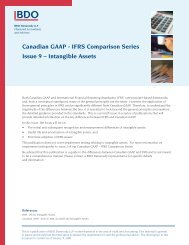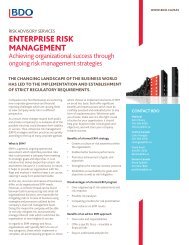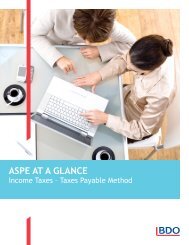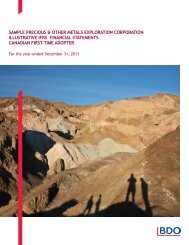need to know / leases - project update - BDO International
need to know / leases - project update - BDO International
need to know / leases - project update - BDO International
Create successful ePaper yourself
Turn your PDF publications into a flip-book with our unique Google optimized e-Paper software.
6 LEASES - A PROJECT UPDATE<br />
THE MAIN PROPOSALS<br />
The main objective of the <strong>project</strong> has been maintained, which is that for most <strong>leases</strong> with a term of one year or more lessees<br />
will record assets and liabilities. There will be two approaches <strong>to</strong> be followed <strong>to</strong> determine the amounts <strong>to</strong> be recorded in<br />
profit or loss; one will result in a higher overall charge in the early periods of a lease due <strong>to</strong> the effect of finance charges<br />
on the lease liability which will decline as the obligation declines over the lease term, while the other will normally result<br />
in an overall constant charge <strong>to</strong> profit or loss over the lease term. The model <strong>to</strong> be followed will depend on the extent of<br />
consumption of the leased asset over the lease term.<br />
For lessors, there will also be two approaches which will be based on the same classification criteria used by lessees. One<br />
approach will result in the recording of the sale of part or all of the leased asset, while the other will result in accounting that is<br />
similar <strong>to</strong> current guidance for operating <strong>leases</strong>.<br />
<strong>BDO</strong> comment<br />
We believe that clear application guidance will <strong>need</strong> <strong>to</strong> be included in the revised proposals, in particular in respect of the new<br />
concept of the ‘extent of consumption of the leased asset’, as the accounting result under each of the two approaches may be<br />
significantly different.<br />
DEFINITION OF A LEASE<br />
When would a contract contain a lease?<br />
An entity would determine whether a contract contains a lease on the basis of the substance of the contract, by assessing<br />
whether the fulfilment of the contract depends on the use of a specified asset (an asset that is explicitly or implicitly<br />
identifiable) and whether the contract conveys the right <strong>to</strong> control the use of that specified asset for a period of time. A right<br />
<strong>to</strong> control the use of an asset is conveyed if the lessee has the ability <strong>to</strong> direct the use, and receive the benefit from that use<br />
throughout the lease term.<br />
The requirement for the arrangement <strong>to</strong> cover a specified asset is an important distinction, as it means that it would be<br />
necessary <strong>to</strong> be able specifically <strong>to</strong> identify the asset (for example, an item of plant and machinery or a building). A physically<br />
distinct portion of a larger asset could also be a specified asset (for example, the first floor of a building, floors 10 <strong>to</strong> 15 of a<br />
20 s<strong>to</strong>rey building or an indentified 100 square metre area of a 1,000 square metre commercial space). However, if a portion<br />
of an asset cannot be specifically identified (for example, a specified proportion of the capacity of a pipeline or of a fibre<br />
optic cable network) that portion is not a specified asset.<br />
What would be the lease term?<br />
The lease term would be the non-cancellable period for which the lessee has contracted with the lessor <strong>to</strong> lease the<br />
underlying asset, <strong>to</strong>gether with the effect of any options <strong>to</strong> extend or terminate the lease when there is a ‘significant<br />
economic incentive’ for an entity <strong>to</strong> exercise an option <strong>to</strong> extend the lease, or for an entity not <strong>to</strong> exercise an option <strong>to</strong><br />
terminate the lease.



